Home / Formation of Grignard and Organolithium Reagents
Organometallics
Formation of Grignard and Organolithium Reagents
Last updated: November 9th, 2022 |
Formation or Grignard Reagents and Organolithium Reagents From Alkyl and Alkenyl Halides
In the last post we introduced the concept of organometallic compounds – molecules where carbon is bound to a less electronegative atom such as Li, Mg, Cu, and many other metals. We said that carbon in these molecules tends to be electron-rich and thus have nucleophilic character, in contrast to functional groups such as alkyl halides, aldehydes, ketones, and epoxides where carbon has electrophilic character. If you need a refresher on what I meant by nucleophilic and electrophilic, read that post first.
In this post we’ll talk about how certain types of organometallic compounds are made – specifically organolithium and Grignard reagents.
Quick summary:
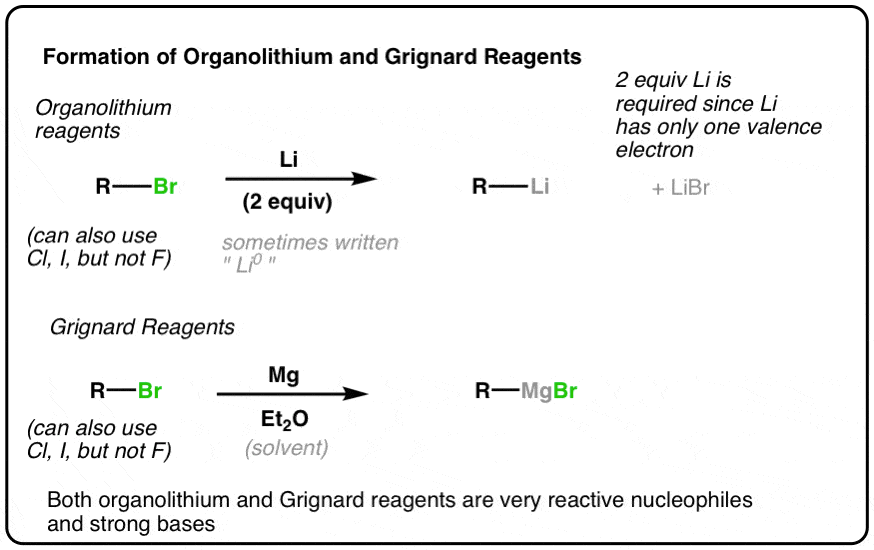
Let’s start with organolithium reagents because they’re the simplest.
Table of Contents
- Organolithium Reagents As Carbanions (The Conjugate Bases Of R-H)
- Making Carbanions Through Reduction, Not Deprotonation
- Formation of Organolithium Reagents From Alkyl Halides
- Formation of Grignard Reagents
- Formation of Grignard Reagents: The Mechanism
- Notes
- (Advanced) References and Further Reading
1. Organolithium Reagents As Carbanions
If you look closely, you can approximate the structure of an organolithium reagent (R-Li) as “R(–)” , with lithium as the positive counter-ion: in other words, a carbon bearing a negative charge (we call these species “carbanions”). If you think back to earlier lessons on acids and bases, this structure might look familiar – it’s the conjugate base of a species R-H.
Using butane to stand in for “R-H” here, we get:
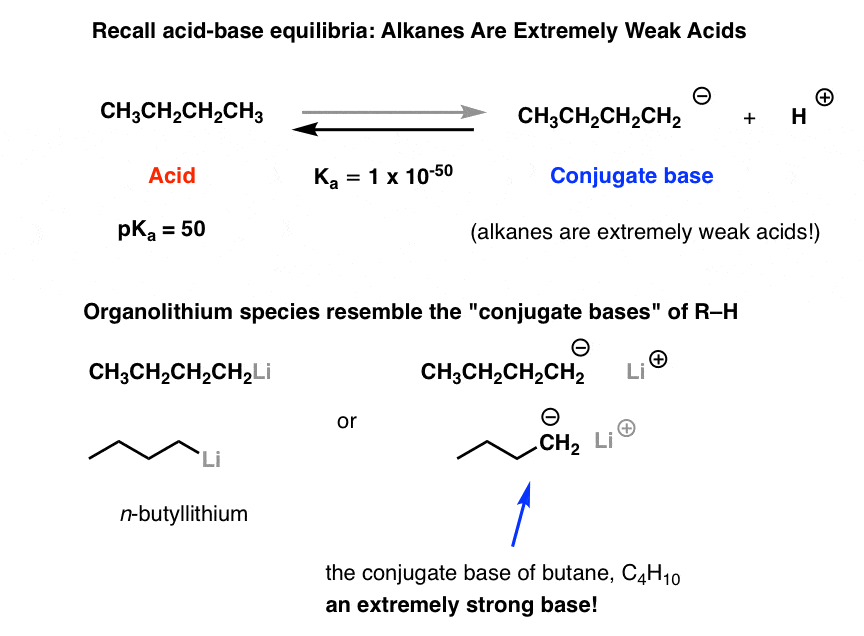
Since conjugate bases are made through deprotonation, we might naively think that we could make organolithium species by taking an organic molecule and just adding a super-strong base to rip off the proton.
If you’ve covered alkynes, you’ve seen that that process actually works pretty well in the case of terminal alkynes. They are quite acidic species, having a pKa of 25 or so. Their unusually high acidity is due to the considerable s-character on the carbon (meaning that the lone pair is held closely to the nucleus).
Trouble is, as we move towards alkenes and alkanes, the direct deprotonation approach doesn’t work so well. That’s because… well, it’s hard to find any species more basic than a deprotonated alkane! Just as the only thing sharp enough to cut a diamond is another diamond, about the only thing basic enough to deprotonate an alkane is… another deprotonated alkane.
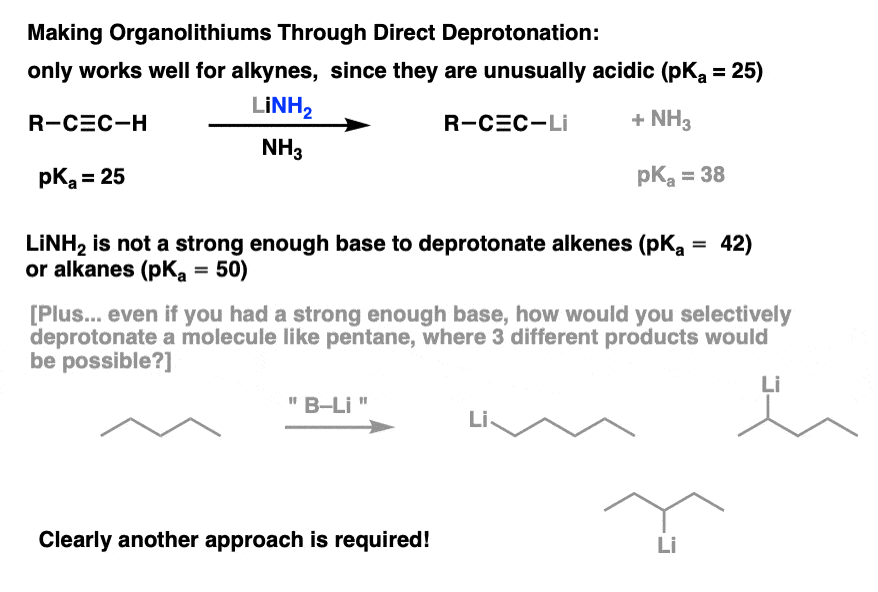
This isn’t a practical approach to make organolithiums for several reasons – primarily, the fact that there are often many C-H bonds and it’s hard to selectively remove just one. [For instance, if you tried to make 1-pentyllithium by deprotonating pentane, you could potentially end up with multiple different isomers].
Thankfully, another approach has been devised.
2. Making Anions Through Reduction, Not Deprotonation
If you look at the reaction below, and count the electrons carefully, you might note that the product has two more electrons than the starting material. In other words, particularly if you remember the OIL RIG mnemonic, reduction has occurred.
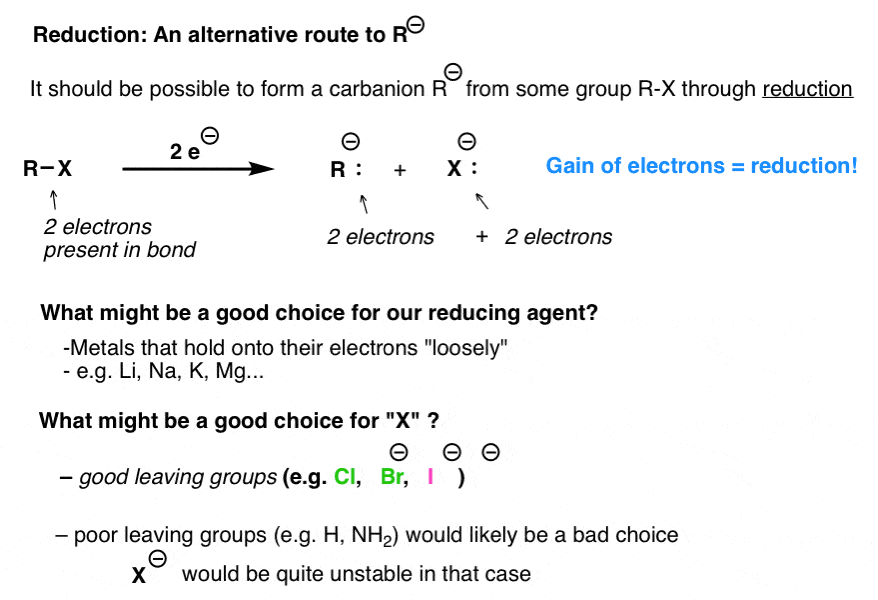
This means that if we were to add some species which was particularly likely to give up its electrons, we might thus be able to effect this transformation.
Can you think of any members of the periodic table which hold onto their electrons particularly loosely? If you said “the far left part of the periodic table” (particularly the alkali and alkaline earths), ding ding ding! you would be correct.
Lithium, in short, would be a great choice as a reductant for this reaction. [We’ll get to the other metals in a minute].
What might be a good choice for X? One factor which would make this reaction easier is if X(–) was a fairly stable species – a good leaving group, in other words. Good candidates for X are halides such as Cl, Br, and I. A bad candidate would be H(–) or some other strongly basic version of R(–) , since we’d be generating another unstable anionic species.
Now let’s get to specifics.
3. Making Organolithium Reagents From Alkyl Halides
Lithium, having a very low ionization energy (i.e. it loses its electron easily) is a powerful reducing agent. Since lithium only has a single valence electron, however, we must add two equivalents if we are to complete the reduction reaction.
To make organolithium reagents, we start with alkyl halides, and add powdered lithium metal (Li or sometimes written as Li0 to distinguish it from the ion Li(+) ).
Occasionally the solvent for this reaction is written below the arrow. A common solvent is pentane. Some instructors like to include it. Some don’t. Regardless of whether it’s written there or not, it doesn’t participate in the reaction.
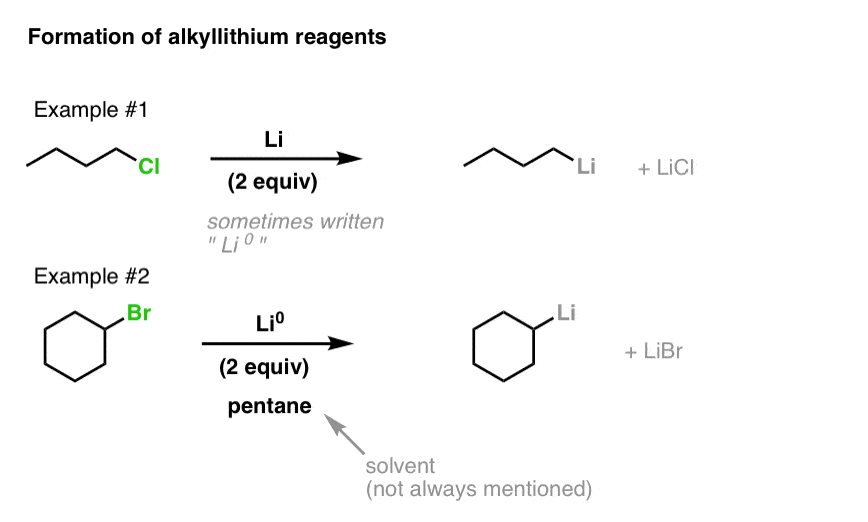
This reaction works for alkyl chlorides, bromides, and iodides, as well as alkenyl halides (fluorides excepted).
If you recall that alkyl halides can be made from halogenation of alkanes, this method thus gives us a 2-step method for formation of highly basic alkyl lithium species from alkanes.
For a pop-up view of the mechanism hover here or click on the link.
We’ll cover the many useful applications of organolithium reagents in a future blog post.
I’m going to skip organoberyllium reagents here (beryllium is highly toxic, and rarely sees use) and move straight across from sodium over to magnesium, which comprises a second very important family of organometallic reagents.
The process for making Grignard reagents is very similar to making organolithium reagents: start with an appropriate alkyl halide and add magnesium. Since magnesium has two valence electrons, only one equivalent of Mg is required to balance the reaction. Here’s two examples, showing formation of alkyl and alkenyl Grignard reagents.
Note that Grignards can be made from alkyl or alkenyl chlorides, bromides, and iodides – but not fluorides.
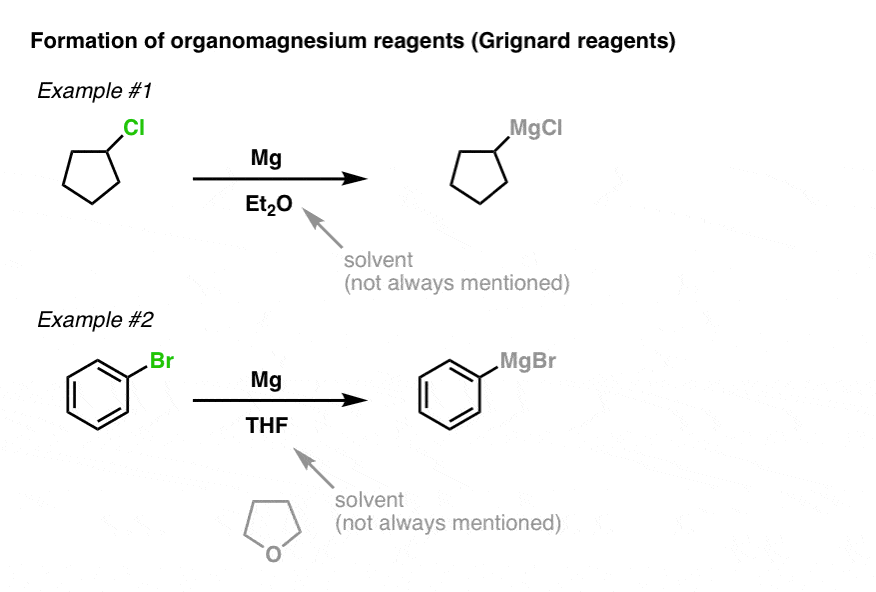
What, you might ask, are Et2O and THF? These are solvents, which are often written in the reaction scheme, but don’t actually participate in the reaction itself. Et2O (diethyl ether, or, sometimes, “ether”) and THF (tetrahydrofuran) are popular choices. If you’re an introductory student, you probably don’t want to know the deeper reasons why, nor do you need to, so don’t click this link to find out.
In contrast with most of the reagents and reactions we talk about at MOC, you’ll likely have personal experience doing this reaction!
Sitting around for a few minutes staring at your flask containing Mg, ether, and organohalide do absolutely nothing is a rite of passage for every student of organic chemistry.
One key contributor to the “finicky” nature of forming Grignard reagents is that the reaction occurs on the surface of the magnesium metal. For this reason the reaction is highly surface area dependent. Breaking the Mg up into very small chunks will accelerate the reaction. Furthermore, Mg that has been sitting out in the open for awhile often has a surface coating of magnesium oxide (MgO) which is unreactive with alkyl halides. Breaking up the surface helps to expose fresh, unoxidized Mg to the reactants. A pinch of iodine (I2) or 1,2-dibromoethane can also help to kick-start things.
5. Formation of Grignard Reagents: The Mechanism
What’s the mechanism of Grignard formation? Usually not covered – it involves free radicals – but if you’re curious, hover here for a pop-up view or click on this link.
From a practical perspective, one key thing to make sure of when preparing organolithium or Grignard reagents is that the solvent and glassware are completely dry. Water (pKa 14) is death to Grignard and organolithium reagents, which as we said above, act as the equivalent of highly basic alkyl and alkenyl anions.
In the next post, we’ll talk about this and also some other complications of making Grignard reagents.
Next post: Organometallics Are Strong Bases
Notes
Related Articles
What about Organosodium Reagents?
So if lithium works, why not go further down the column of the periodic table? Why not use sodium?
This is an excellent idea – sodium is a great reducing agent, after all. The trouble is, when we try to make organosodium reagents from alkyl halides, what tends to happen is that the carbanions that form then go on to react with our starting alkyl halide (in an SN2 process). The result is a pretty useless reaction you likely don’t need to care about that we call Wurtz coupling.
That’s OK, however. Organolithium reagents are plenty reactive enough for almost every purpose that we’d otherwise want organosodium reagents to do. I mean, who needs Chuck Norris when you’ve got Jackie Chan?
Likewise for organopotassium reagents. The one application of organopotassium reagents that sees common use is a reagent called Schlösser’s Base , which is strong enough to deprotonate allylic C-H bonds, something not easily done by organolithium reagents.
(Advanced) References and Further Reading:
- Secondary and Tertiary Alkyllithium Compounds and Some Interconversion Reactions with Them
Henry Gilman, Fred W. Moore, and Ogden Baine
Journal of the American Chemical Society 1941, 63 (9), 2479-2482
DOI: 1021/ja01854a046
Prof. Henry Gilman (Iowa State) was a pioneer in organometallic chemistry in the first half of the 20th century. In this paper he describes the synthesis and reactivity of various alkyllithiums (n-butyllithium, s-butyllithium, isopropyllithium, and t-butyllithium). The synthesis is from the alkyl halide and lithium metal, as can be seen in the experimental section. - t-Butyllithium
Paul D. Bartlett, C. Gardner Swain, and Robert B. Woodward
Journal of the American Chemical Society 1941, 63 (11), 3229-3230
DOI: 1021/ja01856a501
This communication is from some legendary figures in organic chemistry and describes the preparation of t-butyllithium. - 2-PHENYLPYRIDINE
C. W. Evans and C. F. H. Allen
Org. Synth. 1938, 18, 70
DOI: 10.15227/orgsyn.018.0070
The first step in this procedure is a preparation of phenyllithium from bromobenzene and lithium metal. Organic Syntheses is a reputable source of reproducible and independently tested synthetic organic procedures. - The mechanism of the lithium – halogen Interchange reaction : a review of the literature
Bailey, W. F.; Patricia, J. J.
Organomet. Chem. 1988, 352 (1-2), 1-46
DOI: 10.1016/0022-328X(88)83017-1
In modern organic chemistry, organolithium reagents are rarely prepared from scratch (i.e. using Li metal), due to the ready availability of alkyllithium reagents from vendors (e.g. MeLi, the BuLi reagents, PhLi, etc.). Instead, these reagents can be used to form other organolithium species through a process known as lithium-halogen exchange. - What’s Going on with These Lithium Reagents?
Hans J. Reich
The Journal of Organic Chemistry 2012, 77 (13), 5471-5491
DOI: 1021/jo3005155
Prof. Hans Reich (U. Wisconsin-Madison) has spent his career studying the behavior of organolithium species, and this is an account of his research and the surprising findings he made. This is classic Physical Organic chemistry. - Grignard, V. C. Acad. Sci. 1900, 130, 1322-1324
The original paper by Victor Grignard describing a new method for alcohol synthesis from hydrocarbons. - Victor Grignard and Paul Sabatier: Two Showcase Laureates of the Nobel Prize for Chemistry
Henri B. Kagan
Angew. Chem. Int. Ed. 2012, 51, 2-9
DOI: 10.1002/anie.201201849
For those interested in the history of science, this is a historical perspective on the lives of Victor Grignard and Paul Sabatier, and gives insight into their lives, how they made their seminal discoveries, and the impact of their work, among other things. - Mechanical activation of magnesium turnings for the preparation of reactive Grignard reagents
Karen V. Baker, John M. Brown, Nigel Hughes, A. Jerome Skarnulis, and Ann Sexton
The Journal of Organic Chemistry 1991 56 (2), 698-703
DOI: 10.1021/jo00002a039
Sometimes the formation of a Grignard reagent using Mg metal can be challenging, and various methods for activating the metal surface have been developed, including mechanical activation by dry-stirring Mg turnings under an inert atmosphere for several hours.
The following 3 papers are mechanistic studies on the formation of Grignard reagents: - The Mechanism of Formation of Grignard Reagents: Trapping of Free Alkyl Radical Intermediates by Reaction with Tetramethylpiperidine-N-oxyl
Karen S. Root, Craig L. Hill, Lynette M. Lawrence, and George M. Whitesides
Journal of the American Chemical Society 1989 111 (14), 5405-5412
DOI: 10.1021/ja00196a053 - Mechanism of Grignard Reagent Formation. The Surface Nature of the Reaction
M. Walborsky and Janusz Rachon
Journal of the American Chemical Society 1989 111 (5), 1896-1897
DOI: 10.1021/ja00187a063 - Mechanism of Grignard Reagent Formation. Comparisons of D-Model Calculations with Experimental Product Yields
John F. Garst and Brian L. Swift
Journal of the American Chemical Society 1989 111 (1), 241-250
DOI: 10.1021/ja00183a037 - 4-METHOXY-4′-NITROBIPHENYL
K. Stille, Antonio M. Echavarren, Robert M. Williams, and James A. Hendrix
Org. Synth. 1993, 71, 97
DOI: 10.15227/orgsyn.071.0097
The second step in this procedure includes the synthesis of p-anisylmagnesium bromide, which can be a tricky Grignard reagent to prepare and requires special activation of Mg with methyl iodide. - The Grignard Reaction – Unraveling a Chemical Puzzle
Raphael Mathias Peltzer, Jürgen Gauss, Odile Eisenstein, and Michele CascellaJournal of the American Chemical Society 2020 142 (6), 2984-2994
DOI: 10.1021/jacs.9b11829
Recent (and open-access) article that suggests that the reaction “does not occur via a single process but by an ensemble of parallel reactions.”
00 General Chemistry Review
01 Bonding, Structure, and Resonance
- How Do We Know Methane (CH4) Is Tetrahedral?
- Hybrid Orbitals and Hybridization
- How To Determine Hybridization: A Shortcut
- Orbital Hybridization And Bond Strengths
- Sigma bonds come in six varieties: Pi bonds come in one
- A Key Skill: How to Calculate Formal Charge
- The Four Intermolecular Forces and How They Affect Boiling Points
- 3 Trends That Affect Boiling Points
- How To Use Electronegativity To Determine Electron Density (and why NOT to trust formal charge)
- Introduction to Resonance
- How To Use Curved Arrows To Interchange Resonance Forms
- Evaluating Resonance Forms (1) - The Rule of Least Charges
- How To Find The Best Resonance Structure By Applying Electronegativity
- Evaluating Resonance Structures With Negative Charges
- Evaluating Resonance Structures With Positive Charge
- Exploring Resonance: Pi-Donation
- Exploring Resonance: Pi-acceptors
- In Summary: Evaluating Resonance Structures
- Drawing Resonance Structures: 3 Common Mistakes To Avoid
- How to apply electronegativity and resonance to understand reactivity
- Bond Hybridization Practice
- Structure and Bonding Practice Quizzes
- Resonance Structures Practice
02 Acid Base Reactions
- Introduction to Acid-Base Reactions
- Acid Base Reactions In Organic Chemistry
- The Stronger The Acid, The Weaker The Conjugate Base
- Walkthrough of Acid-Base Reactions (3) - Acidity Trends
- Five Key Factors That Influence Acidity
- Acid-Base Reactions: Introducing Ka and pKa
- How to Use a pKa Table
- The pKa Table Is Your Friend
- A Handy Rule of Thumb for Acid-Base Reactions
- Acid Base Reactions Are Fast
- pKa Values Span 60 Orders Of Magnitude
- How Protonation and Deprotonation Affect Reactivity
- Acid Base Practice Problems
03 Alkanes and Nomenclature
- Meet the (Most Important) Functional Groups
- Condensed Formulas: Deciphering What the Brackets Mean
- Hidden Hydrogens, Hidden Lone Pairs, Hidden Counterions
- Don't Be Futyl, Learn The Butyls
- Primary, Secondary, Tertiary, Quaternary In Organic Chemistry
- Branching, and Its Affect On Melting and Boiling Points
- The Many, Many Ways of Drawing Butane
- Wedge And Dash Convention For Tetrahedral Carbon
- Common Mistakes in Organic Chemistry: Pentavalent Carbon
- Table of Functional Group Priorities for Nomenclature
- Summary Sheet - Alkane Nomenclature
- Organic Chemistry IUPAC Nomenclature Demystified With A Simple Puzzle Piece Approach
- Boiling Point Quizzes
- Organic Chemistry Nomenclature Quizzes
04 Conformations and Cycloalkanes
- Staggered vs Eclipsed Conformations of Ethane
- Conformational Isomers of Propane
- Newman Projection of Butane (and Gauche Conformation)
- Introduction to Cycloalkanes
- Geometric Isomers In Small Rings: Cis And Trans Cycloalkanes
- Calculation of Ring Strain In Cycloalkanes
- Cycloalkanes - Ring Strain In Cyclopropane And Cyclobutane
- Cyclohexane Conformations
- Cyclohexane Chair Conformation: An Aerial Tour
- How To Draw The Cyclohexane Chair Conformation
- The Cyclohexane Chair Flip
- The Cyclohexane Chair Flip - Energy Diagram
- Substituted Cyclohexanes - Axial vs Equatorial
- Ranking The Bulkiness Of Substituents On Cyclohexanes: "A-Values"
- Cyclohexane Chair Conformation Stability: Which One Is Lower Energy?
- Fused Rings - Cis-Decalin and Trans-Decalin
- Naming Bicyclic Compounds - Fused, Bridged, and Spiro
- Bredt's Rule (And Summary of Cycloalkanes)
- Newman Projection Practice
- Cycloalkanes Practice Problems
05 A Primer On Organic Reactions
- The Most Important Question To Ask When Learning a New Reaction
- Curved Arrows (for reactions)
- Nucleophiles and Electrophiles
- The Three Classes of Nucleophiles
- Nucleophilicity vs. Basicity
- What Makes A Good Nucleophile?
- What Makes A Good Leaving Group?
- 3 Factors That Stabilize Carbocations
- Equilibrium and Energy Relationships
- 7 Factors that stabilize negative charge in organic chemistry
- 7 Factors That Stabilize Positive Charge in Organic Chemistry
- What's a Transition State?
- Hammond's Postulate
- Learning Organic Chemistry Reactions: A Checklist (PDF)
- Introduction to Oxidative Cleavage Reactions
06 Free Radical Reactions
- Bond Dissociation Energies = Homolytic Cleavage
- Free Radical Reactions
- 3 Factors That Stabilize Free Radicals
- What Factors Destabilize Free Radicals?
- Bond Strengths And Radical Stability
- Free Radical Initiation: Why Is "Light" Or "Heat" Required?
- Initiation, Propagation, Termination
- Monochlorination Products Of Propane, Pentane, And Other Alkanes
- Selectivity In Free Radical Reactions
- Selectivity in Free Radical Reactions: Bromination vs. Chlorination
- Halogenation At Tiffany's
- Allylic Bromination
- Bonus Topic: Allylic Rearrangements
- In Summary: Free Radicals
- Synthesis (2) - Reactions of Alkanes
- Free Radicals Practice Quizzes
07 Stereochemistry and Chirality
- Types of Isomers: Constitutional Isomers, Stereoisomers, Enantiomers, and Diastereomers
- How To Draw The Enantiomer Of A Chiral Molecule
- How To Draw A Bond Rotation
- Introduction to Assigning (R) and (S): The Cahn-Ingold-Prelog Rules
- Assigning Cahn-Ingold-Prelog (CIP) Priorities (2) - The Method of Dots
- Enantiomers vs Diastereomers vs The Same? Two Methods For Solving Problems
- Assigning R/S To Newman Projections (And Converting Newman To Line Diagrams)
- How To Determine R and S Configurations On A Fischer Projection
- The Meso Trap
- Optical Rotation, Optical Activity, and Specific Rotation
- Optical Purity and Enantiomeric Excess
- What's a Racemic Mixture?
- Chiral Allenes And Chiral Axes
- Stereochemistry Practice Problems and Quizzes
08 Substitution Reactions
- Nucleophilic Substitution Reactions - Introduction
- Two Types of Nucleophilic Substitution Reactions
- The SN2 Mechanism
- Why the SN2 Reaction Is Powerful
- The SN1 Mechanism
- The Conjugate Acid Is A Better Leaving Group
- Comparing the SN1 and SN2 Reactions
- Polar Protic? Polar Aprotic? Nonpolar? All About Solvents
- Steric Hindrance is Like a Fat Goalie
- Common Blind Spot: Intramolecular Reactions
- Substitution Practice - SN1
- Substitution Practice - SN2
09 Elimination Reactions
- Elimination Reactions (1): Introduction And The Key Pattern
- Elimination Reactions (2): The Zaitsev Rule
- Elimination Reactions Are Favored By Heat
- Two Elimination Reaction Patterns
- The E1 Reaction
- The E2 Mechanism
- E1 vs E2: Comparing the E1 and E2 Reactions
- Antiperiplanar Relationships: The E2 Reaction and Cyclohexane Rings
- Bulky Bases in Elimination Reactions
- Comparing the E1 vs SN1 Reactions
- Elimination (E1) Reactions With Rearrangements
- E1cB - Elimination (Unimolecular) Conjugate Base
- Elimination (E1) Practice Problems And Solutions
- Elimination (E2) Practice Problems and Solutions
10 Rearrangements
11 SN1/SN2/E1/E2 Decision
- Identifying Where Substitution and Elimination Reactions Happen
- Deciding SN1/SN2/E1/E2 (1) - The Substrate
- Deciding SN1/SN2/E1/E2 (2) - The Nucleophile/Base
- SN1 vs E1 and SN2 vs E2 : The Temperature
- Deciding SN1/SN2/E1/E2 - The Solvent
- Wrapup: The Key Factors For Determining SN1/SN2/E1/E2
- Alkyl Halide Reaction Map And Summary
- SN1 SN2 E1 E2 Practice Problems
12 Alkene Reactions
- E and Z Notation For Alkenes (+ Cis/Trans)
- Alkene Stability
- Alkene Addition Reactions: "Regioselectivity" and "Stereoselectivity" (Syn/Anti)
- Stereoselective and Stereospecific Reactions
- Hydrohalogenation of Alkenes and Markovnikov's Rule
- Hydration of Alkenes With Aqueous Acid
- Rearrangements in Alkene Addition Reactions
- Halogenation of Alkenes and Halohydrin Formation
- Oxymercuration Demercuration of Alkenes
- Hydroboration Oxidation of Alkenes
- m-CPBA (meta-chloroperoxybenzoic acid)
- OsO4 (Osmium Tetroxide) for Dihydroxylation of Alkenes
- Palladium on Carbon (Pd/C) for Catalytic Hydrogenation of Alkenes
- Cyclopropanation of Alkenes
- A Fourth Alkene Addition Pattern - Free Radical Addition
- Alkene Reactions: Ozonolysis
- Summary: Three Key Families Of Alkene Reaction Mechanisms
- Synthesis (4) - Alkene Reaction Map, Including Alkyl Halide Reactions
- Alkene Reactions Practice Problems
13 Alkyne Reactions
- Acetylides from Alkynes, And Substitution Reactions of Acetylides
- Partial Reduction of Alkynes With Lindlar's Catalyst
- Partial Reduction of Alkynes With Na/NH3 To Obtain Trans Alkenes
- Alkyne Hydroboration With "R2BH"
- Hydration and Oxymercuration of Alkynes
- Hydrohalogenation of Alkynes
- Alkyne Halogenation: Bromination, Chlorination, and Iodination of Alkynes
- Alkyne Reactions - The "Concerted" Pathway
- Alkenes To Alkynes Via Halogenation And Elimination Reactions
- Alkynes Are A Blank Canvas
- Synthesis (5) - Reactions of Alkynes
- Alkyne Reactions Practice Problems With Answers
14 Alcohols, Epoxides and Ethers
- Alcohols - Nomenclature and Properties
- Alcohols Can Act As Acids Or Bases (And Why It Matters)
- Alcohols - Acidity and Basicity
- The Williamson Ether Synthesis
- Ethers From Alkenes, Tertiary Alkyl Halides and Alkoxymercuration
- Alcohols To Ethers via Acid Catalysis
- Cleavage Of Ethers With Acid
- Epoxides - The Outlier Of The Ether Family
- Opening of Epoxides With Acid
- Epoxide Ring Opening With Base
- Making Alkyl Halides From Alcohols
- Tosylates And Mesylates
- PBr3 and SOCl2
- Elimination Reactions of Alcohols
- Elimination of Alcohols To Alkenes With POCl3
- Alcohol Oxidation: "Strong" and "Weak" Oxidants
- Demystifying The Mechanisms of Alcohol Oxidations
- Protecting Groups For Alcohols
- Thiols And Thioethers
- Calculating the oxidation state of a carbon
- Oxidation and Reduction in Organic Chemistry
- Oxidation Ladders
- SOCl2 Mechanism For Alcohols To Alkyl Halides: SN2 versus SNi
- Alcohol Reactions Roadmap (PDF)
- Alcohol Reaction Practice Problems
- Epoxide Reaction Quizzes
- Oxidation and Reduction Practice Quizzes
15 Organometallics
- What's An Organometallic?
- Formation of Grignard and Organolithium Reagents
- Organometallics Are Strong Bases
- Reactions of Grignard Reagents
- Protecting Groups In Grignard Reactions
- Synthesis Problems Involving Grignard Reagents
- Grignard Reactions And Synthesis (2)
- Organocuprates (Gilman Reagents): How They're Made
- Gilman Reagents (Organocuprates): What They're Used For
- The Heck, Suzuki, and Olefin Metathesis Reactions (And Why They Don't Belong In Most Introductory Organic Chemistry Courses)
- Reaction Map: Reactions of Organometallics
- Grignard Practice Problems
16 Spectroscopy
- Degrees of Unsaturation (or IHD, Index of Hydrogen Deficiency)
- Conjugation And Color (+ How Bleach Works)
- Introduction To UV-Vis Spectroscopy
- UV-Vis Spectroscopy: Absorbance of Carbonyls
- UV-Vis Spectroscopy: Practice Questions
- Bond Vibrations, Infrared Spectroscopy, and the "Ball and Spring" Model
- Infrared Spectroscopy: A Quick Primer On Interpreting Spectra
- IR Spectroscopy: 4 Practice Problems
- 1H NMR: How Many Signals?
- Homotopic, Enantiotopic, Diastereotopic
- Diastereotopic Protons in 1H NMR Spectroscopy: Examples
- 13-C NMR - How Many Signals
- Liquid Gold: Pheromones In Doe Urine
- Natural Product Isolation (1) - Extraction
- Natural Product Isolation (2) - Purification Techniques, An Overview
- Structure Determination Case Study: Deer Tarsal Gland Pheromone
17 Dienes and MO Theory
- What To Expect In Organic Chemistry 2
- Are these molecules conjugated?
- Conjugation And Resonance In Organic Chemistry
- Bonding And Antibonding Pi Orbitals
- Molecular Orbitals of The Allyl Cation, Allyl Radical, and Allyl Anion
- Pi Molecular Orbitals of Butadiene
- Reactions of Dienes: 1,2 and 1,4 Addition
- Thermodynamic and Kinetic Products
- More On 1,2 and 1,4 Additions To Dienes
- s-cis and s-trans
- The Diels-Alder Reaction
- Cyclic Dienes and Dienophiles in the Diels-Alder Reaction
- Stereochemistry of the Diels-Alder Reaction
- Exo vs Endo Products In The Diels Alder: How To Tell Them Apart
- HOMO and LUMO In the Diels Alder Reaction
- Why Are Endo vs Exo Products Favored in the Diels-Alder Reaction?
- Diels-Alder Reaction: Kinetic and Thermodynamic Control
- The Retro Diels-Alder Reaction
- The Intramolecular Diels Alder Reaction
- Regiochemistry In The Diels-Alder Reaction
- The Cope and Claisen Rearrangements
- Electrocyclic Reactions
- Electrocyclic Ring Opening And Closure (2) - Six (or Eight) Pi Electrons
- Diels Alder Practice Problems
- Molecular Orbital Theory Practice
18 Aromaticity
- Introduction To Aromaticity
- Rules For Aromaticity
- Huckel's Rule: What Does 4n+2 Mean?
- Aromatic, Non-Aromatic, or Antiaromatic? Some Practice Problems
- Antiaromatic Compounds and Antiaromaticity
- The Pi Molecular Orbitals of Benzene
- The Pi Molecular Orbitals of Cyclobutadiene
- Frost Circles
- Aromaticity Practice Quizzes
19 Reactions of Aromatic Molecules
- Electrophilic Aromatic Substitution: Introduction
- Activating and Deactivating Groups In Electrophilic Aromatic Substitution
- Electrophilic Aromatic Substitution - The Mechanism
- Ortho-, Para- and Meta- Directors in Electrophilic Aromatic Substitution
- Understanding Ortho, Para, and Meta Directors
- Why are halogens ortho- para- directors?
- Disubstituted Benzenes: The Strongest Electron-Donor "Wins"
- Electrophilic Aromatic Substitutions (1) - Halogenation of Benzene
- Electrophilic Aromatic Substitutions (2) - Nitration and Sulfonation
- EAS Reactions (3) - Friedel-Crafts Acylation and Friedel-Crafts Alkylation
- Intramolecular Friedel-Crafts Reactions
- Nucleophilic Aromatic Substitution (NAS)
- Nucleophilic Aromatic Substitution (2) - The Benzyne Mechanism
- Reactions on the "Benzylic" Carbon: Bromination And Oxidation
- The Wolff-Kishner, Clemmensen, And Other Carbonyl Reductions
- More Reactions on the Aromatic Sidechain: Reduction of Nitro Groups and the Baeyer Villiger
- Aromatic Synthesis (1) - "Order Of Operations"
- Synthesis of Benzene Derivatives (2) - Polarity Reversal
- Aromatic Synthesis (3) - Sulfonyl Blocking Groups
- Birch Reduction
- Synthesis (7): Reaction Map of Benzene and Related Aromatic Compounds
- Aromatic Reactions and Synthesis Practice
- Electrophilic Aromatic Substitution Practice Problems
20 Aldehydes and Ketones
- What's The Alpha Carbon In Carbonyl Compounds?
- Nucleophilic Addition To Carbonyls
- Aldehydes and Ketones: 14 Reactions With The Same Mechanism
- Sodium Borohydride (NaBH4) Reduction of Aldehydes and Ketones
- Grignard Reagents For Addition To Aldehydes and Ketones
- Wittig Reaction
- Hydrates, Hemiacetals, and Acetals
- Imines - Properties, Formation, Reactions, and Mechanisms
- All About Enamines
- Breaking Down Carbonyl Reaction Mechanisms: Reactions of Anionic Nucleophiles (Part 2)
- Aldehydes Ketones Reaction Practice
21 Carboxylic Acid Derivatives
- Nucleophilic Acyl Substitution (With Negatively Charged Nucleophiles)
- Addition-Elimination Mechanisms With Neutral Nucleophiles (Including Acid Catalysis)
- Basic Hydrolysis of Esters - Saponification
- Transesterification
- Proton Transfer
- Fischer Esterification - Carboxylic Acid to Ester Under Acidic Conditions
- Lithium Aluminum Hydride (LiAlH4) For Reduction of Carboxylic Acid Derivatives
- LiAlH[Ot-Bu]3 For The Reduction of Acid Halides To Aldehydes
- Di-isobutyl Aluminum Hydride (DIBAL) For The Partial Reduction of Esters and Nitriles
- Amide Hydrolysis
- Thionyl Chloride (SOCl2)
- Diazomethane (CH2N2)
- Carbonyl Chemistry: Learn Six Mechanisms For the Price Of One
- Making Music With Mechanisms (PADPED)
- Carboxylic Acid Derivatives Practice Questions
22 Enols and Enolates
- Keto-Enol Tautomerism
- Enolates - Formation, Stability, and Simple Reactions
- Kinetic Versus Thermodynamic Enolates
- Aldol Addition and Condensation Reactions
- Reactions of Enols - Acid-Catalyzed Aldol, Halogenation, and Mannich Reactions
- Claisen Condensation and Dieckmann Condensation
- Decarboxylation
- The Malonic Ester and Acetoacetic Ester Synthesis
- The Michael Addition Reaction and Conjugate Addition
- The Robinson Annulation
- Haloform Reaction
- The Hell–Volhard–Zelinsky Reaction
- Enols and Enolates Practice Quizzes
23 Amines
- The Amide Functional Group: Properties, Synthesis, and Nomenclature
- Basicity of Amines And pKaH
- 5 Key Basicity Trends of Amines
- The Mesomeric Effect And Aromatic Amines
- Nucleophilicity of Amines
- Alkylation of Amines (Sucks!)
- Reductive Amination
- The Gabriel Synthesis
- Some Reactions of Azides
- The Hofmann Elimination
- The Hofmann and Curtius Rearrangements
- The Cope Elimination
- Protecting Groups for Amines - Carbamates
- The Strecker Synthesis of Amino Acids
- Introduction to Peptide Synthesis
- Reactions of Diazonium Salts: Sandmeyer and Related Reactions
- Amine Practice Questions
24 Carbohydrates
- D and L Notation For Sugars
- Pyranoses and Furanoses: Ring-Chain Tautomerism In Sugars
- What is Mutarotation?
- Reducing Sugars
- The Big Damn Post Of Carbohydrate-Related Chemistry Definitions
- The Haworth Projection
- Converting a Fischer Projection To A Haworth (And Vice Versa)
- Reactions of Sugars: Glycosylation and Protection
- The Ruff Degradation and Kiliani-Fischer Synthesis
- Isoelectric Points of Amino Acids (and How To Calculate Them)
- Carbohydrates Practice
- Amino Acid Quizzes
25 Fun and Miscellaneous
- A Gallery of Some Interesting Molecules From Nature
- Screw Organic Chemistry, I'm Just Going To Write About Cats
- On Cats, Part 1: Conformations and Configurations
- On Cats, Part 2: Cat Line Diagrams
- On Cats, Part 4: Enantiocats
- On Cats, Part 6: Stereocenters
- Organic Chemistry Is Shit
- The Organic Chemistry Behind "The Pill"
- Maybe they should call them, "Formal Wins" ?
- Why Do Organic Chemists Use Kilocalories?
- The Principle of Least Effort
- Organic Chemistry GIFS - Resonance Forms
- Reproducibility In Organic Chemistry
- What Holds The Nucleus Together?
- How Reactions Are Like Music
- Organic Chemistry and the New MCAT
26 Organic Chemistry Tips and Tricks
- Common Mistakes: Formal Charges Can Mislead
- Partial Charges Give Clues About Electron Flow
- Draw The Ugly Version First
- Organic Chemistry Study Tips: Learn the Trends
- The 8 Types of Arrows In Organic Chemistry, Explained
- Top 10 Skills To Master Before An Organic Chemistry 2 Final
- Common Mistakes with Carbonyls: Carboxylic Acids... Are Acids!
- Planning Organic Synthesis With "Reaction Maps"
- Alkene Addition Pattern #1: The "Carbocation Pathway"
- Alkene Addition Pattern #2: The "Three-Membered Ring" Pathway
- Alkene Addition Pattern #3: The "Concerted" Pathway
- Number Your Carbons!
- The 4 Major Classes of Reactions in Org 1
- How (and why) electrons flow
- Grossman's Rule
- Three Exam Tips
- A 3-Step Method For Thinking Through Synthesis Problems
- Putting It Together
- Putting Diels-Alder Products in Perspective
- The Ups and Downs of Cyclohexanes
- The Most Annoying Exceptions in Org 1 (Part 1)
- The Most Annoying Exceptions in Org 1 (Part 2)
- The Marriage May Be Bad, But the Divorce Still Costs Money
- 9 Nomenclature Conventions To Know
- Nucleophile attacks Electrophile
27 Case Studies of Successful O-Chem Students
- Success Stories: How Corina Got The The "Hard" Professor - And Got An A+ Anyway
- How Helena Aced Organic Chemistry
- From a "Drop" To B+ in Org 2 – How A Hard Working Student Turned It Around
- How Serge Aced Organic Chemistry
- Success Stories: How Zach Aced Organic Chemistry 1
- Success Stories: How Kari Went From C– to B+
- How Esther Bounced Back From a "C" To Get A's In Organic Chemistry 1 And 2
- How Tyrell Got The Highest Grade In Her Organic Chemistry Course
- This Is Why Students Use Flashcards
- Success Stories: How Stu Aced Organic Chemistry
- How John Pulled Up His Organic Chemistry Exam Grades
- Success Stories: How Nathan Aced Organic Chemistry (Without It Taking Over His Life)
- How Chris Aced Org 1 and Org 2
- Interview: How Jay Got an A+ In Organic Chemistry
- How to Do Well in Organic Chemistry: One Student's Advice
- "America's Top TA" Shares His Secrets For Teaching O-Chem
- "Organic Chemistry Is Like..." - A Few Metaphors
- How To Do Well In Organic Chemistry: Advice From A Tutor
- Guest post: "I went from being afraid of tests to actually looking forward to them".
We are all aware that doctoral students have to remember a lot of things when studying. It has been observed in various instances that if memorization is practiced on a regular basis and in certain instances, the student may forget something, however, when we apply the method of scientific memorization, it’s very simple.
To help you, here is a fantastic mnemonic method site I discovered while researching.
https://sciencemnemonic.com
Should be a carbanion. Is there a typo somewhere I’m not seeing?
The grignard reagent (say Ch3mgbr) can act as a base here thereby abstracting the acidic hydrogen from terminal triple bond carbon. But still we get a carbocation!!
Why can’t 3-bromoprop-1-yne form grignard reagent?
First, draw out (or at least imagine) the Grignard that would form from 3-bromoprop-1-yne.
Next, think about how basic this species is. Remember the pKa’s of alkanes are around 50 (this one would be slightly less, but still).
Are there any acidic protons around that could react with this very basic Grignard reagent?
Thanks for sharing!
So because of Schlenk equilibrium, Et2O or THF is necessary for the synthesis of Grignard reagents, right? My research project now requires Grignard reagents, but THF or Et2O is not good for the whole reaction system, I’m trying to synthesize Grignard reagents in some non-polar solvents such as toluene, I’m wondering if it’s possible?
Do they need to be Grignards? Or can they be organolithium reagents?
Yeah, we need Grignard reagents because lithium introduces impurity to our system
What happen when lithium bromide reacts with water ? Do it dissociate into ions or not?
Also can you tell me the reaction when lithium bromide added to silk fibrion protein?
Yes, LiBr dissociates, although you’d have to look up the solubility in water to get a precise number.
how activate the lithium metal for synthesis of organolithium on industrial and laboratory scale?
From my friend Jeff, who regularly used Li metal to make lithium di-tertbutyl diphenylide (LDBB).
Lithium prep:
tweezers
1 pair of needle-nose pliers
Lithium wire (usually with a small % of Na in it) in oil
3 beakers: hexane, THF, and MeOH, and then a 4th with reaction solvent (or just the reaction itself, with an ARGON atmosphere, preferably)
Cut wire into pieces with scissors or pliers and put into hexanes
Use tweezers to fish out a piece of Li and squish with pliers and return to hexanes
Once all the pieces have been pressed, use tweezers and take a piece out of hexanes and dip in THF then MeOH then THF again and then into the reaction solvent/flask.
Repeat with remaining pieces of Li
is there a reason that orgo students learn about both grignard and organolithium reagents if they do the same thing which acts as a strong nucleophile/base? is there a certain advantage one has over the other
Good question. For most purposes it’s like choosing between Chuck Norris and Jackie Chan. They both get the job done. Organolithium reagents are are generally less compatible with a range of functional groups than Grignards are.
One thing that organolithium reagents can do that Grignards cannot is add to carboxylic acids. For your purposes that’s likely the most important distinction. [Advanced purposes: organolithium reagents will also do a reaction called “lithium halogen exchange” which Grignards generally don’t do].
Is this covered in your revision guide?
It’s in the reagent guide, yes!
Thank you for sharing. Hope to hear more from you.
May also want to mention that these days, chemists usually buy their Grignards from Aldrich rather than make them.
True enough! Although it’s handy to know how they’re made if you need a fairly obscure one.
Great post. Two observations, though:
– “Note that Grignards can be made from alkyl or alkenyl chlorides, bromides, and iodides…”; you could add aryl halides, especially since Example #2;
– the last link (for the mechanism of Grignard formation) actually leads to the last figure in this post.
thank you, as always.